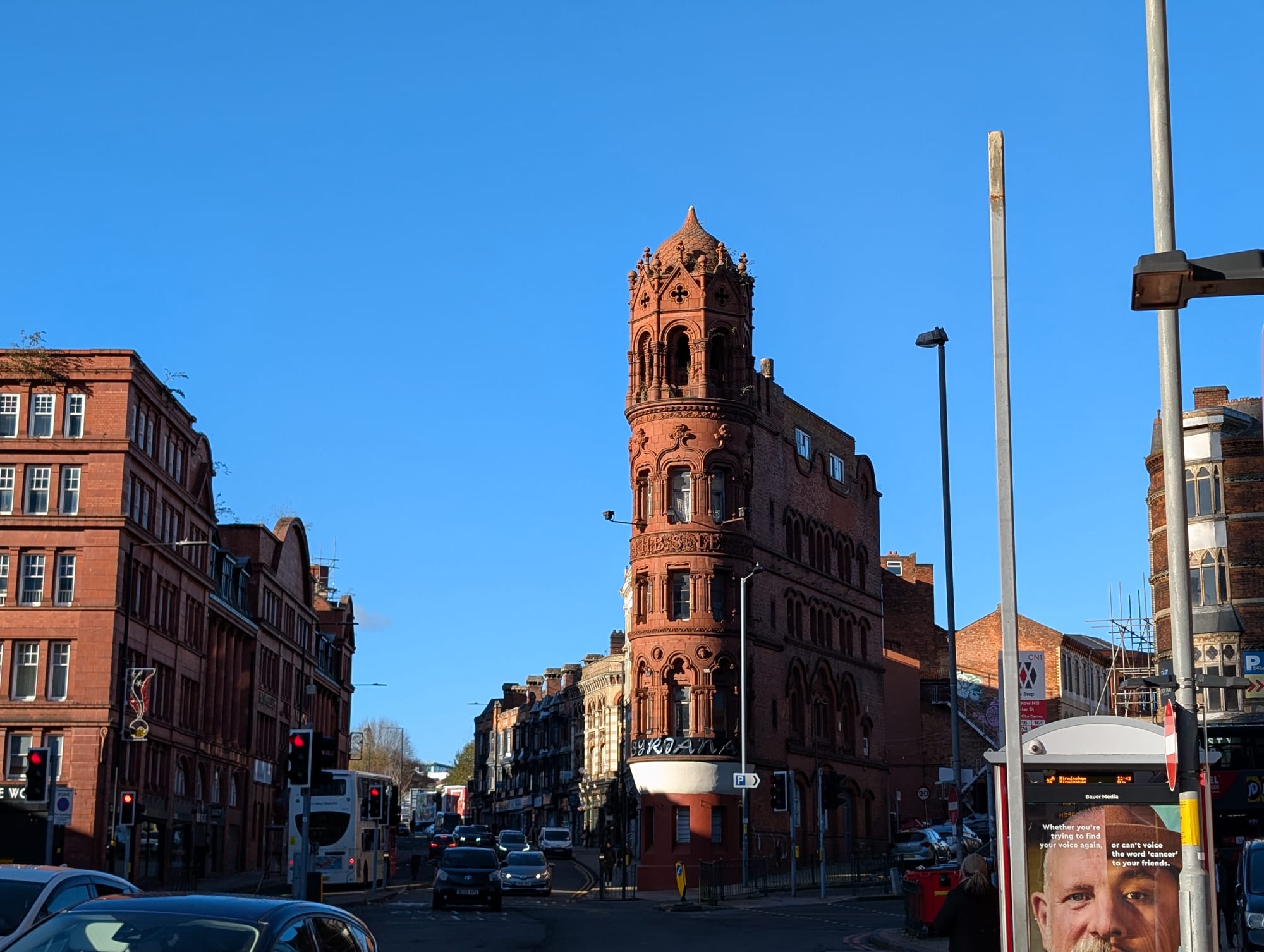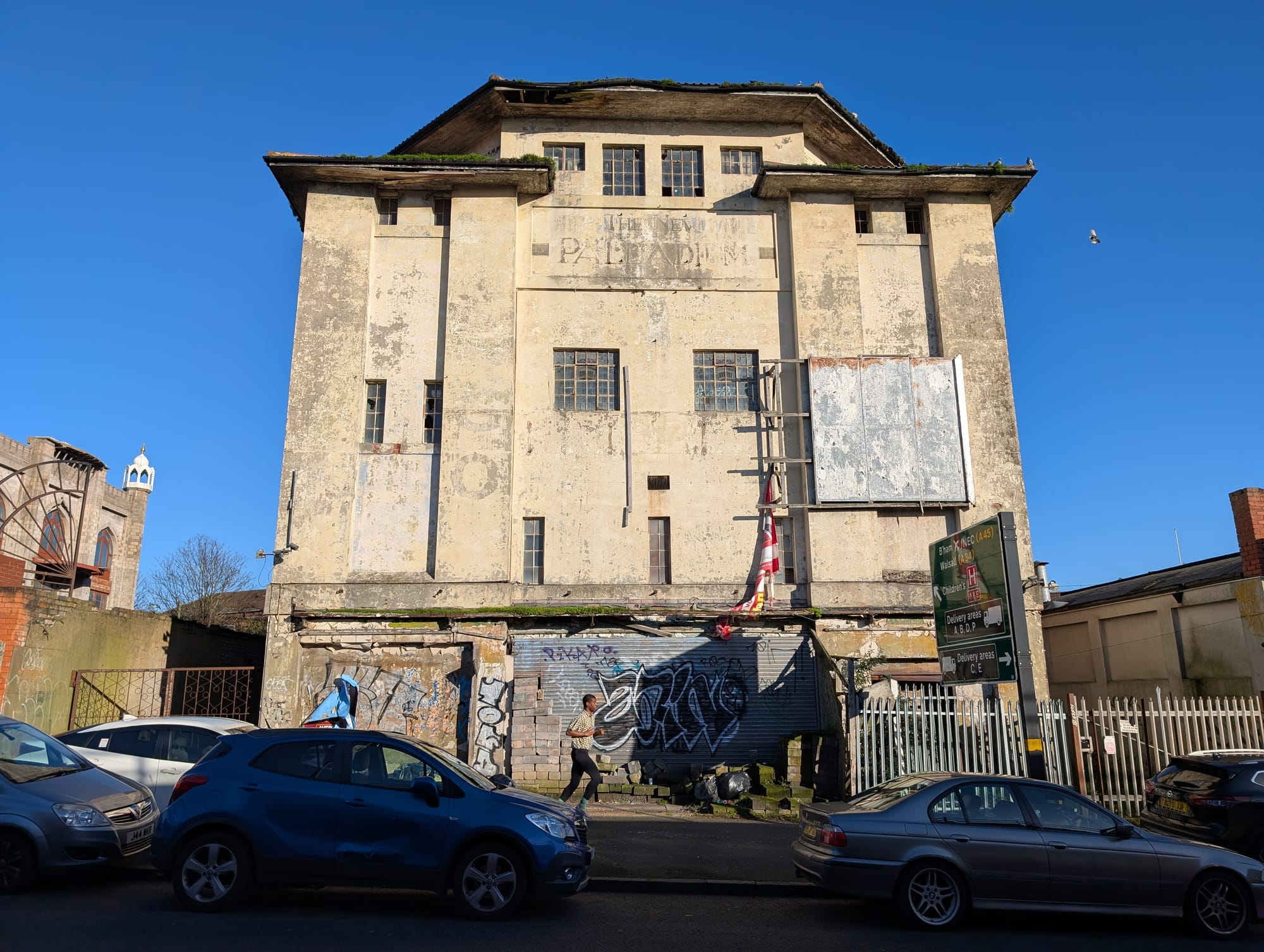Dear readers — it is, by now, a bit cliché to say that Birmingham is no good at bigging itself up. But if some of the buildings that feature in today's story were in other major cities around the world, you can bet they would be loved, celebrated and on the top of any tourist's must see list. Writer and author Samantha Lyster has long-loved these gems, all of which are easily reachable by catching the no.16 bus from town to Handsworth. More on that below, but first, your Brum in Brief.
Brum in Brief
⚖️ Raise the Colours co-founder Ryan Bridge could be forced to swap his expensive home in Bromsgrove for a Spanish jail cell if he's found guilty of aggravated fraud and membership of a criminal organisation. The 44-year-old face of Birmingham's flagging phenomenon faces a potential eight year jail sentence in Spain as lawyers representing three hotel groups are seeking criminal convictions for his alleged part in a holiday sickness scam. As we reported last month, Bridge and seven others are accused of running a racket, encouraging British holidaymakers to submit bogus food poisoning claims. (Mirror).
🚮 Birmingham City Council has been accused of 'bullying' bin lorry drivers by 'ranking' their performances in a 'league table' pinned to the staff room wall. The council has denied the allegations. (Birmingham Mail).
🐕 Aston Villas women's team met a pack of puppies found abandoned in a nearby rubbish dump. The six female Staffordshire Bull-Terrier pups have been rescued by Birmingham Dogs Home and are expected to be up for adoption next month. (BBC).
Today, hop aboard the No. 16 bus for an unofficial tour-through-time.
On a surprisingly warm November day I’m hurrying through the city centre eager to claim my seat on a time machine. It’s not as fantastical as the one in the H.G Wells novella, but the No 16 bus does have one distinct advantage: for the price of a day ticket, it will propel passengers into previous centuries.
From its top deck you can journey through Birmingham’s past lives as it passes an assortment of historical buildings — it’s a thrilling compendium of pre-Millennium architecture. If the route I’m following today, from Snowhill Square to Handsworth Park, was in Paris or Rome, it would be on every Instagram visitor’s wish list. Unfortunately, it’s trending on social media for all the wrong reasons. The in-frequent patches of piled-up rubbish on the streets of Hockley and Handsworth have become a national talking point.
But don’t let the bin strike and media furore put you off enjoying this feast of design. I’ve adored this stretch of Birmingham since I first experienced it in 2017, on my way to the Sandwell Reserve as part of my then-work for the RSPB.
You could say I was late to the party, as its treasures are long known to local residents and the city’s various heritage societies, but not having family or friends in the area, there was never a reason to take the journey before. So I spent a jaw-dropping 40 minutes soaking in beautiful building after beautiful building as we snaked our way from town towards Handsworth.
From grand Victorian piles, to slices of Georgian, Edwardian, 1930s modernism and mid-Century, each structure is a character in the story of Birmingham's economic and social development.

Today, I’m retracing my path, but this time, I’m bringing along the softly spoken but formidable expert in heritage buildings, Katriona Byrne. As Birmingham City University’s senior lecturer in conservation of the historic environment, Byrne is a font of local knowledge. And, not content to simply pick her brains over the phone, I’ve asked her to join me on this journey through time.
We board the bus outside One Snowhill tower and soon we’re approaching the slim terracotta wedge of a building that was once home to the H.B Sale Ltd metalworks — and which happens to be my favourite building of the entire tour. This Grade II listed slither guards the mouth of Constitution Hill and is often described as Birmingham’s answer to New York's Flat Iron, the 22-story triangular pyramid that sits proudly on Fifth Avenue in Manhattan.
Birmingham’s (rather shorter) flatiron is flanked by more Gothic Revival buildings leading Byrne to dub the area the ‘Gothic Quarter’. “What we see here are buildings designed to present not just wealth and success but also the cleverness and craftsmanship of the builders,” says Byrne. “The businesses invested in these buildings and they didn’t scrimp on them either.”
The bus rattles along and we soon hit Hockley Circus, where a swathe of buildings were famously demolished to build a flyover in 1968. One that escaped the bulldozers was the magnificent Grade II* Icknield Street School, built in 1883 and designed by J.H. Chamberlain – a contemporary but not relation of the Victorian mayor Joseph Chamberlain. Surrounded by boxy modern sheds, the school is a joyful sight, with its decorative tiled roof and slated spire peeking heavenwards.
It's easy to be absorbed by the architecture above ground, but Byrne and I are just quick enough to look down into the depths of the flyover's amphitheatre-like concourse, to catch a glimpse of the Grade II listed William Mitchell murals. The three concrete murals — also known as the Brutalist Climbing Wall — decorate the pedestrian entrance to the underpass in distinctive Aztec-like patterns of sunbursts, donut-shapes and shards.

Without time to waste, our own vehicle hurtles towards Handsworth Park, where Byrne and I step off for some fresh air and a wander. First, we visit the Grade II* St Mary’s Church, home to memorials of Boulton, Watt and Murdoch — founders of the industrial revolution — strolling through the surrounding graveyard and then the park itself.
There is an abundance of Victorian houses surrounding the park that were built for the emerging middle class of the ‘town of 1000 trades’. Post-war, many were bought and spliced up by landlords into rooms for rent to the sons and daughters of the Commonwealth, where they were joined by Irish workers. Sitting proudly in the park is a mixed-metal sculpture by the artist Luke Perry, which honours the Windrush generation and migrants of all nationalities. Had Robert Jenrick, on his now viral, litter-spotting trip to Handsworth in February, visited the park he might have noticed that the grounds are used by a mixture of locals and in pristine order.
All apart from Lodge House, that is. Built in 1897 and once home to the park’s warden, the two-storey, half-timbered cottage with a clock tower turret is in a sorry state today. The now-boarded-up building has suffered arson attacks and the Victorian Society is worried it may not survive if left empty for much longer. More engagement is needed, conservation adviser Tim Bridges tells me, “like Heritage Open Days to try to involve local people in opportunities to protect heritage.”
Bridges adds that there are local groups interested in helping the society’s conservation efforts, including the Sikh Community at the Gurdwara in Soho Road. “[They] would like to talk more about how we can work together on trying to save more of Handsworth’s Victorian and Edwardian buildings, and hope to arrange a meeting with them in the very near future.”
The support is much needed. On our journey we see a number of buildings in poor repair, clinging onto their original features like ageing Hollywood divas. Byrne often points out the unchecked growth of buddleia, a building’s horticultural nemesis, sprouting from brickwork. A major issue is that many buildings are not listed and lack the legal protections that this brings. Anyone can put a building or site of architectural interest forward to Historic England for listing — but this isn’t common knowledge.

In my opinion, one of the problems is Birmingham City Council delaying the publication of its heritage strategy. There’s one due to be put to its cabinet in March, but that’s seven years since the last one — plenty of time for ailing buildings to decline further. Byrne and I chat about the city’s conservation issues as we exit the park for the journey back to the city centre. The bus we flag down is bustling with passengers, a mix of the elderly with their shopping trolleys and students clutching their phones.
But as we pull up to the junction of Villa Road and Hamstead Road, I can’t help but suggest we jump off to admire the Grade II Toll House with its stunning black and white, Tudor Revival facade. It was built in 1904 on the site of a former Toll House that dated from 1727 and presided over what was once an important route for transporting coal from the Black Country to Birmingham’s furnaces.
The current building has had several tenants over the years from a private girls school to the home of Ellis Travel, the business of former chairman of Aston Villa and package holiday pioneer Doug Ellis. It brings to mind advice I was once given on a heritage walk: “always look up as that’s where the good stuff is”. In this case, when I tilt my head to the sky, I’m greeted with panels decorated with peacocks and dragon-like creatures — a touch of Harry Potter in Handsworth.
We walk down Hamstead Road to the row of nine Grade II Georgian terrace houses saved from dereliction by heritage enthusiast Colin Simms, who bought no 42 in 1979, and then acquired the adjoining houses over the next 31 years.
The properties date from 1795 and were once owned by Arthur Peel, the son of prime minister and founder of the Metropolitan Police Sir Robert Peel. They were apparently given to him as part of a dowry when he married Adelaide Dugdale, daughter of Sir William Dugdale, in 1862. Simms sold them in 2021 and, unfortunately, it appears a couple of them are shuttered and not in use.
Byrne’s attention is drawn to a large white house opposite the Georgian terrace. She looks beyond its tatty curtains and metal grills to identify it as a Regency building. “This would most likely have been part of a pair, or even a row of Regency villas,” she adds, pointing to the jagged edge to the left of the villa where misshapen bricks are all that’s left of what may have been a similar structure and is now a car wash.

Our final stop is the fascinating former New Palladium building on Soho Hill, which first opened as a classic one-screen cinema theatre called the Hockley Picture House in 1911. Its facade is in poor condition, but its original metal and stained glass windows have survived. There are patches of colour showing through the peeling paint, which Byrne thinks could be pink or blue, a reminder of when it was a pleasure palace for entertaining local residents.
Peering at the shedding paintwork and the original building peeking from underneath, I’m reminded that Birmingham’s history is built into our material surroundings. New ages are layered on top of old, waiting to be rediscovered — all it takes is someone to pay attention. If you want a closer look at Birmingham’s past, I can suggest no better place to start than by boarding the no.16 bus.
Samantha Lyster is the author of Irish Emigration to England Explored Through Buildings, published by Historic England/Liverpool University Press. She is hosting the free event Beyond Shelter: How Buildings Build Communities at 1000 Trades in the Jewellery Quarter on Tuesday, 2 December.
If someone forwarded you this newsletter, click here to sign up to get quality local journalism in your inbox.







Comments